Sustainable Finance: Evaluating Green REITs and Asian Impact Investing
VerifiedAdded on 2023/06/09
|11
|2253
|414
Report
AI Summary
This report provides a critical evaluation of Green Real Estate Investment Trusts (REITs) and Asian impact investing funds, focusing on their financial and operating models, as well as the social and environmental metrics used to measure their impact. It examines the financial models employed by Green REITs, including relative pricing and net asset value models, and discusses key valuation metrics such as adjusted funds from operation and funds from operation. The report also analyzes the Lotus Funds, an Asian impact investing fund, detailing its financial and operating models, and highlighting the integration of IRIS metrics for measuring social and environmental performance. Ultimately, the report underscores the potential for aligning financial objectives with sustainability goals in real estate and investment.
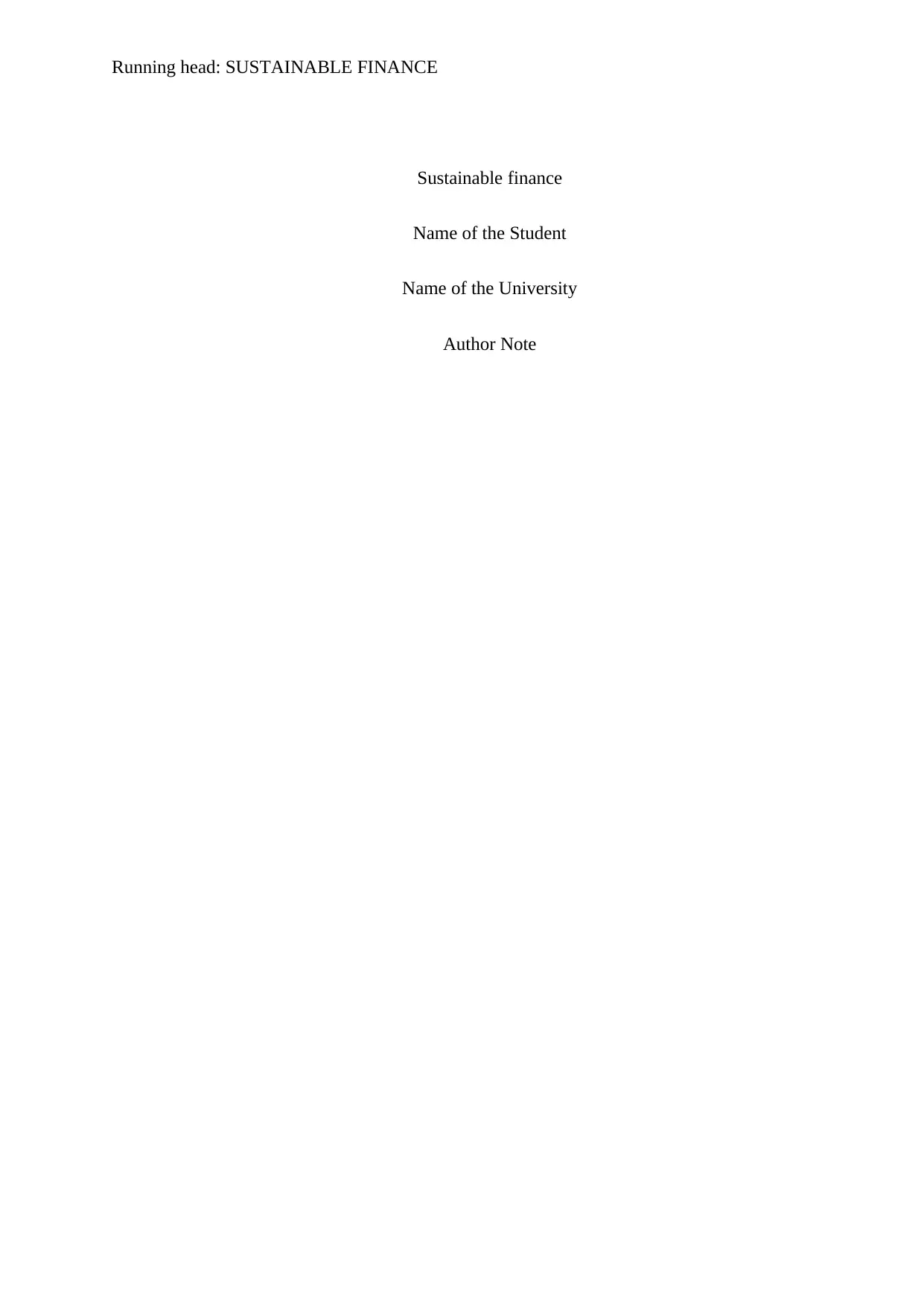
Running head: SUSTAINABLE FINANCE
Sustainable finance
Name of the Student
Name of the University
Author Note
Sustainable finance
Name of the Student
Name of the University
Author Note
Paraphrase This Document
Need a fresh take? Get an instant paraphrase of this document with our AI Paraphraser
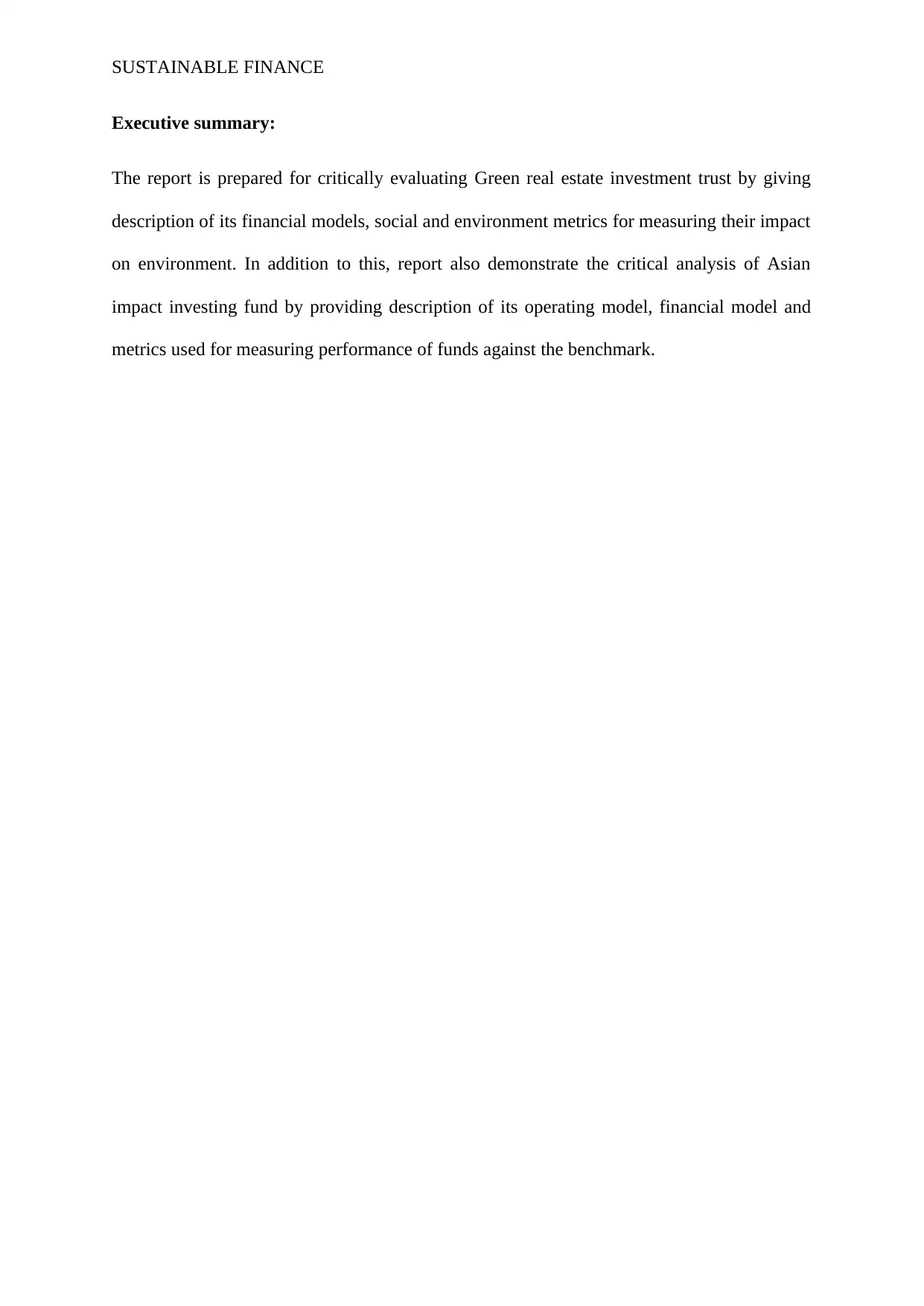
SUSTAINABLE FINANCE
Executive summary:
The report is prepared for critically evaluating Green real estate investment trust by giving
description of its financial models, social and environment metrics for measuring their impact
on environment. In addition to this, report also demonstrate the critical analysis of Asian
impact investing fund by providing description of its operating model, financial model and
metrics used for measuring performance of funds against the benchmark.
Executive summary:
The report is prepared for critically evaluating Green real estate investment trust by giving
description of its financial models, social and environment metrics for measuring their impact
on environment. In addition to this, report also demonstrate the critical analysis of Asian
impact investing fund by providing description of its operating model, financial model and
metrics used for measuring performance of funds against the benchmark.
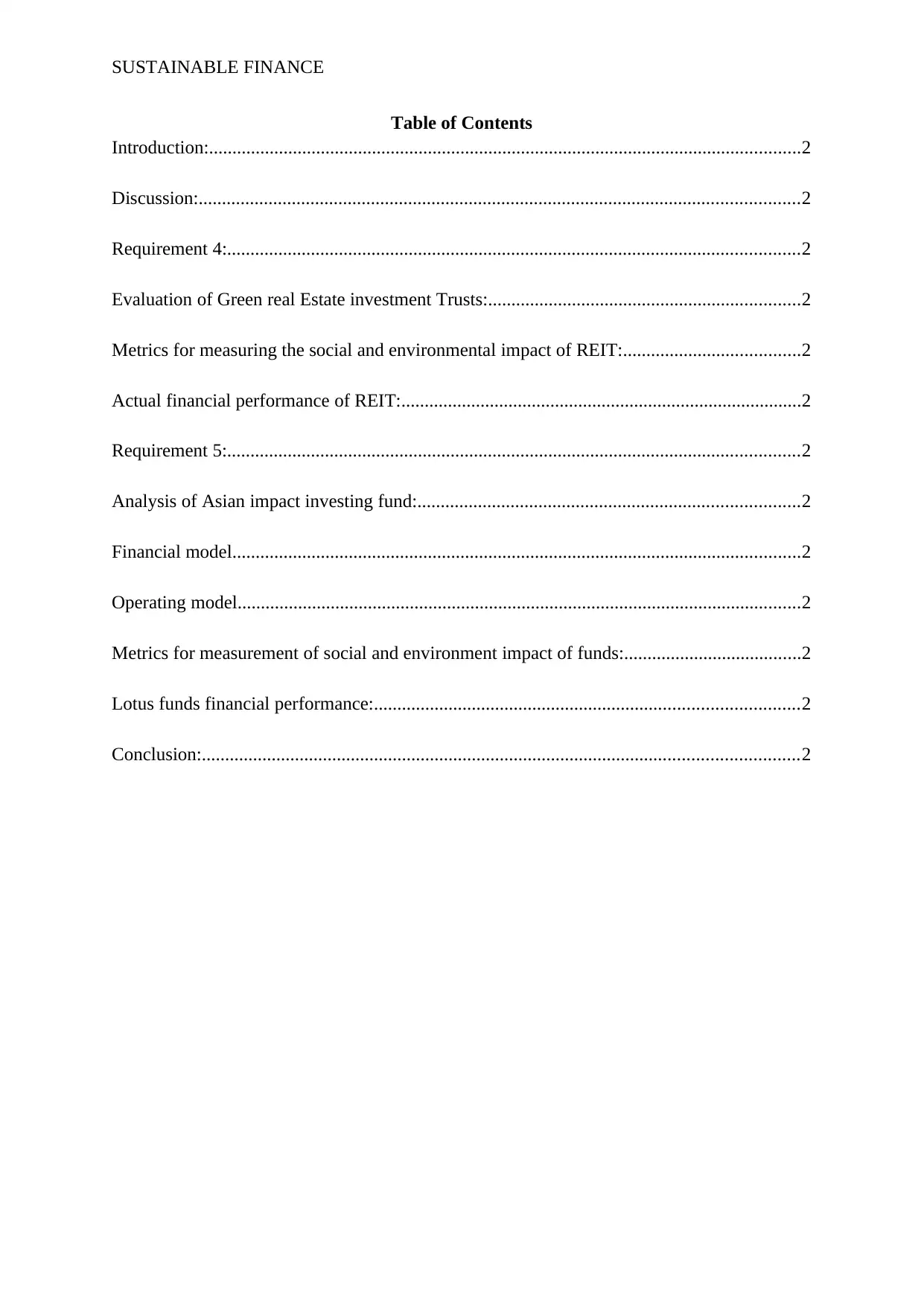
SUSTAINABLE FINANCE
Table of Contents
Introduction:...............................................................................................................................2
Discussion:.................................................................................................................................2
Requirement 4:...........................................................................................................................2
Evaluation of Green real Estate investment Trusts:...................................................................2
Metrics for measuring the social and environmental impact of REIT:......................................2
Actual financial performance of REIT:......................................................................................2
Requirement 5:...........................................................................................................................2
Analysis of Asian impact investing fund:..................................................................................2
Financial model..........................................................................................................................2
Operating model.........................................................................................................................2
Metrics for measurement of social and environment impact of funds:......................................2
Lotus funds financial performance:...........................................................................................2
Conclusion:................................................................................................................................2
Table of Contents
Introduction:...............................................................................................................................2
Discussion:.................................................................................................................................2
Requirement 4:...........................................................................................................................2
Evaluation of Green real Estate investment Trusts:...................................................................2
Metrics for measuring the social and environmental impact of REIT:......................................2
Actual financial performance of REIT:......................................................................................2
Requirement 5:...........................................................................................................................2
Analysis of Asian impact investing fund:..................................................................................2
Financial model..........................................................................................................................2
Operating model.........................................................................................................................2
Metrics for measurement of social and environment impact of funds:......................................2
Lotus funds financial performance:...........................................................................................2
Conclusion:................................................................................................................................2
⊘ This is a preview!⊘
Do you want full access?
Subscribe today to unlock all pages.

Trusted by 1+ million students worldwide
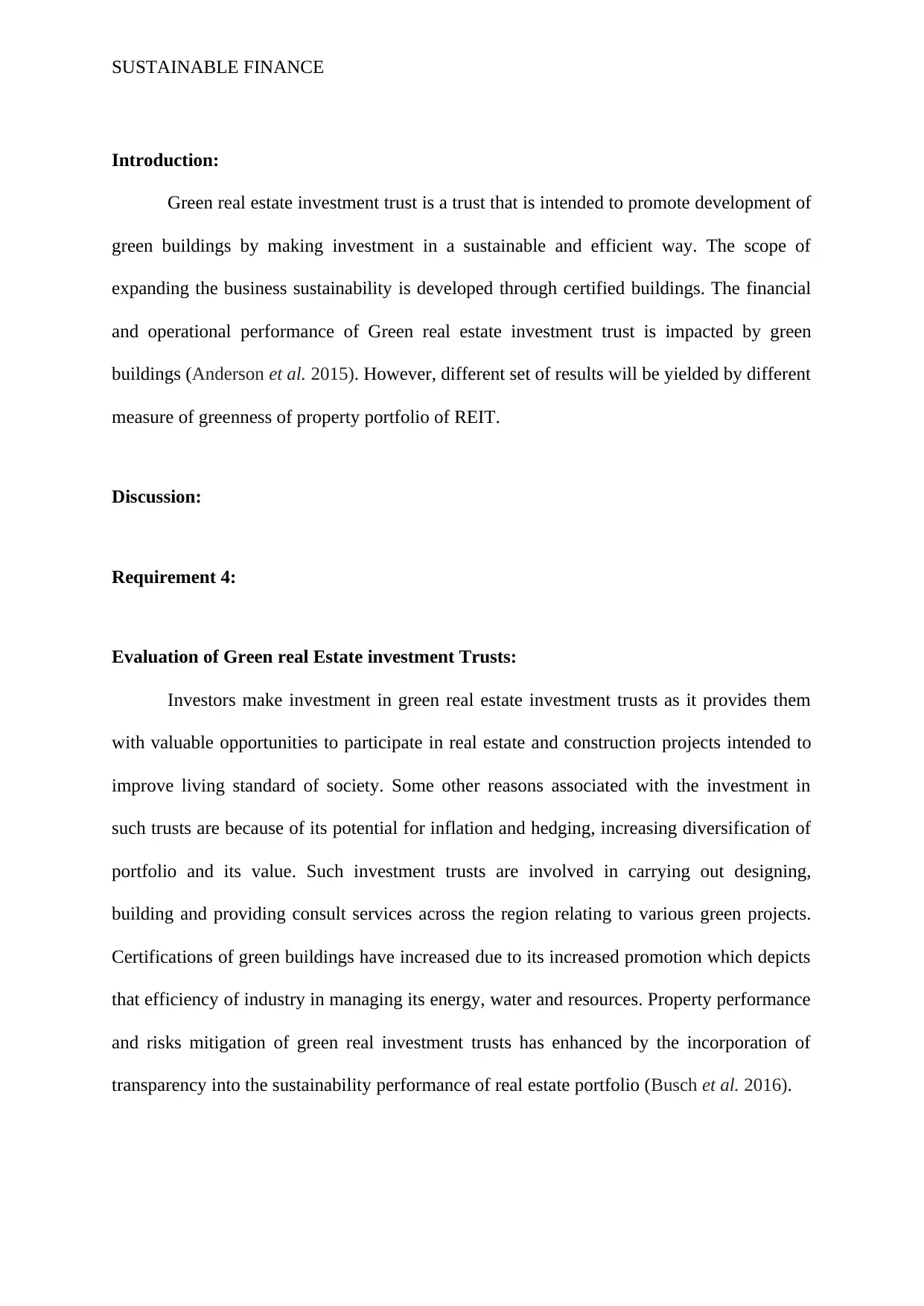
SUSTAINABLE FINANCE
Introduction:
Green real estate investment trust is a trust that is intended to promote development of
green buildings by making investment in a sustainable and efficient way. The scope of
expanding the business sustainability is developed through certified buildings. The financial
and operational performance of Green real estate investment trust is impacted by green
buildings (Anderson et al. 2015). However, different set of results will be yielded by different
measure of greenness of property portfolio of REIT.
Discussion:
Requirement 4:
Evaluation of Green real Estate investment Trusts:
Investors make investment in green real estate investment trusts as it provides them
with valuable opportunities to participate in real estate and construction projects intended to
improve living standard of society. Some other reasons associated with the investment in
such trusts are because of its potential for inflation and hedging, increasing diversification of
portfolio and its value. Such investment trusts are involved in carrying out designing,
building and providing consult services across the region relating to various green projects.
Certifications of green buildings have increased due to its increased promotion which depicts
that efficiency of industry in managing its energy, water and resources. Property performance
and risks mitigation of green real investment trusts has enhanced by the incorporation of
transparency into the sustainability performance of real estate portfolio (Busch et al. 2016).
Introduction:
Green real estate investment trust is a trust that is intended to promote development of
green buildings by making investment in a sustainable and efficient way. The scope of
expanding the business sustainability is developed through certified buildings. The financial
and operational performance of Green real estate investment trust is impacted by green
buildings (Anderson et al. 2015). However, different set of results will be yielded by different
measure of greenness of property portfolio of REIT.
Discussion:
Requirement 4:
Evaluation of Green real Estate investment Trusts:
Investors make investment in green real estate investment trusts as it provides them
with valuable opportunities to participate in real estate and construction projects intended to
improve living standard of society. Some other reasons associated with the investment in
such trusts are because of its potential for inflation and hedging, increasing diversification of
portfolio and its value. Such investment trusts are involved in carrying out designing,
building and providing consult services across the region relating to various green projects.
Certifications of green buildings have increased due to its increased promotion which depicts
that efficiency of industry in managing its energy, water and resources. Property performance
and risks mitigation of green real investment trusts has enhanced by the incorporation of
transparency into the sustainability performance of real estate portfolio (Busch et al. 2016).
Paraphrase This Document
Need a fresh take? Get an instant paraphrase of this document with our AI Paraphraser
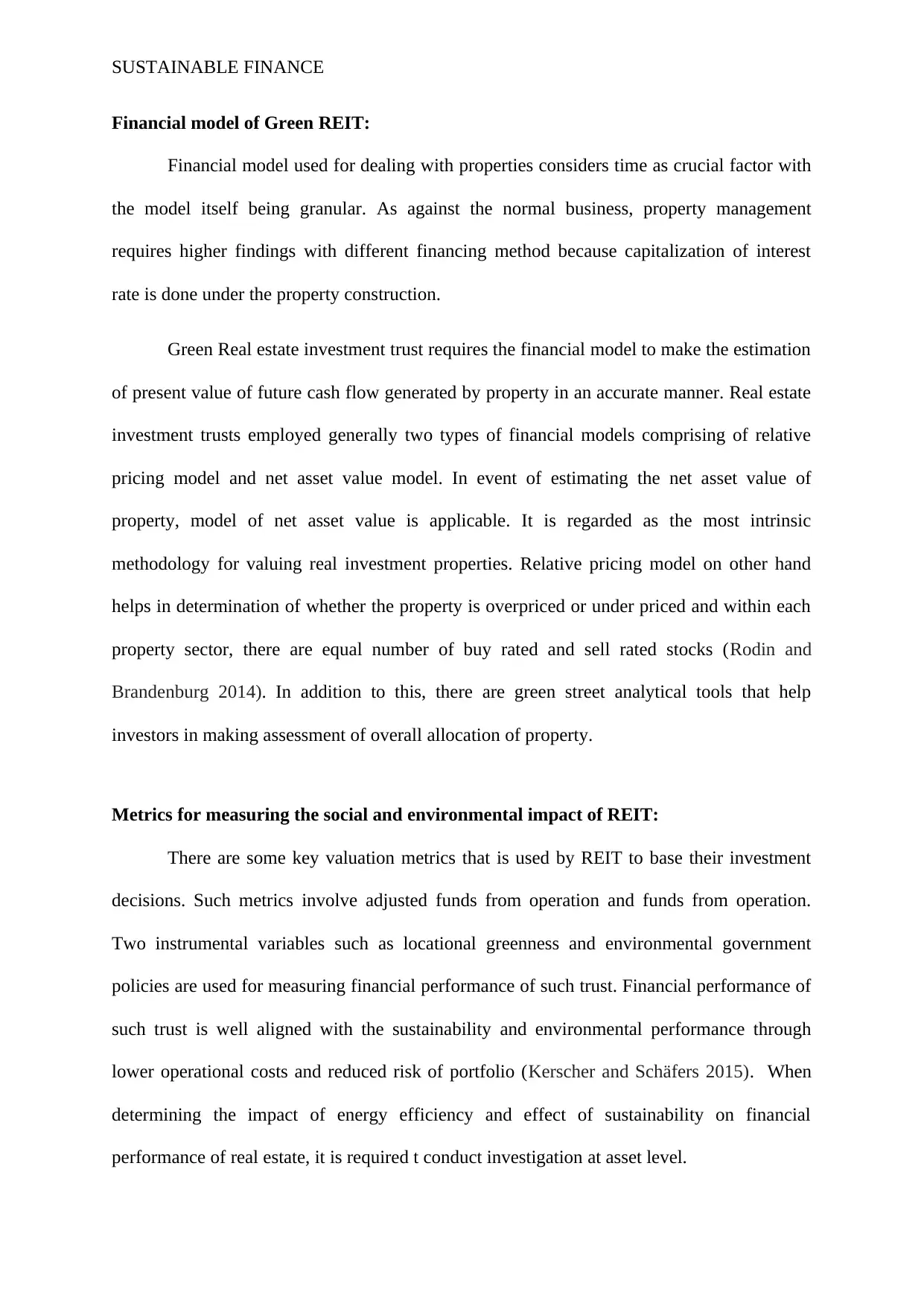
SUSTAINABLE FINANCE
Financial model of Green REIT:
Financial model used for dealing with properties considers time as crucial factor with
the model itself being granular. As against the normal business, property management
requires higher findings with different financing method because capitalization of interest
rate is done under the property construction.
Green Real estate investment trust requires the financial model to make the estimation
of present value of future cash flow generated by property in an accurate manner. Real estate
investment trusts employed generally two types of financial models comprising of relative
pricing model and net asset value model. In event of estimating the net asset value of
property, model of net asset value is applicable. It is regarded as the most intrinsic
methodology for valuing real investment properties. Relative pricing model on other hand
helps in determination of whether the property is overpriced or under priced and within each
property sector, there are equal number of buy rated and sell rated stocks (Rodin and
Brandenburg 2014). In addition to this, there are green street analytical tools that help
investors in making assessment of overall allocation of property.
Metrics for measuring the social and environmental impact of REIT:
There are some key valuation metrics that is used by REIT to base their investment
decisions. Such metrics involve adjusted funds from operation and funds from operation.
Two instrumental variables such as locational greenness and environmental government
policies are used for measuring financial performance of such trust. Financial performance of
such trust is well aligned with the sustainability and environmental performance through
lower operational costs and reduced risk of portfolio (Kerscher and Schäfers 2015). When
determining the impact of energy efficiency and effect of sustainability on financial
performance of real estate, it is required t conduct investigation at asset level.
Financial model of Green REIT:
Financial model used for dealing with properties considers time as crucial factor with
the model itself being granular. As against the normal business, property management
requires higher findings with different financing method because capitalization of interest
rate is done under the property construction.
Green Real estate investment trust requires the financial model to make the estimation
of present value of future cash flow generated by property in an accurate manner. Real estate
investment trusts employed generally two types of financial models comprising of relative
pricing model and net asset value model. In event of estimating the net asset value of
property, model of net asset value is applicable. It is regarded as the most intrinsic
methodology for valuing real investment properties. Relative pricing model on other hand
helps in determination of whether the property is overpriced or under priced and within each
property sector, there are equal number of buy rated and sell rated stocks (Rodin and
Brandenburg 2014). In addition to this, there are green street analytical tools that help
investors in making assessment of overall allocation of property.
Metrics for measuring the social and environmental impact of REIT:
There are some key valuation metrics that is used by REIT to base their investment
decisions. Such metrics involve adjusted funds from operation and funds from operation.
Two instrumental variables such as locational greenness and environmental government
policies are used for measuring financial performance of such trust. Financial performance of
such trust is well aligned with the sustainability and environmental performance through
lower operational costs and reduced risk of portfolio (Kerscher and Schäfers 2015). When
determining the impact of energy efficiency and effect of sustainability on financial
performance of real estate, it is required t conduct investigation at asset level.
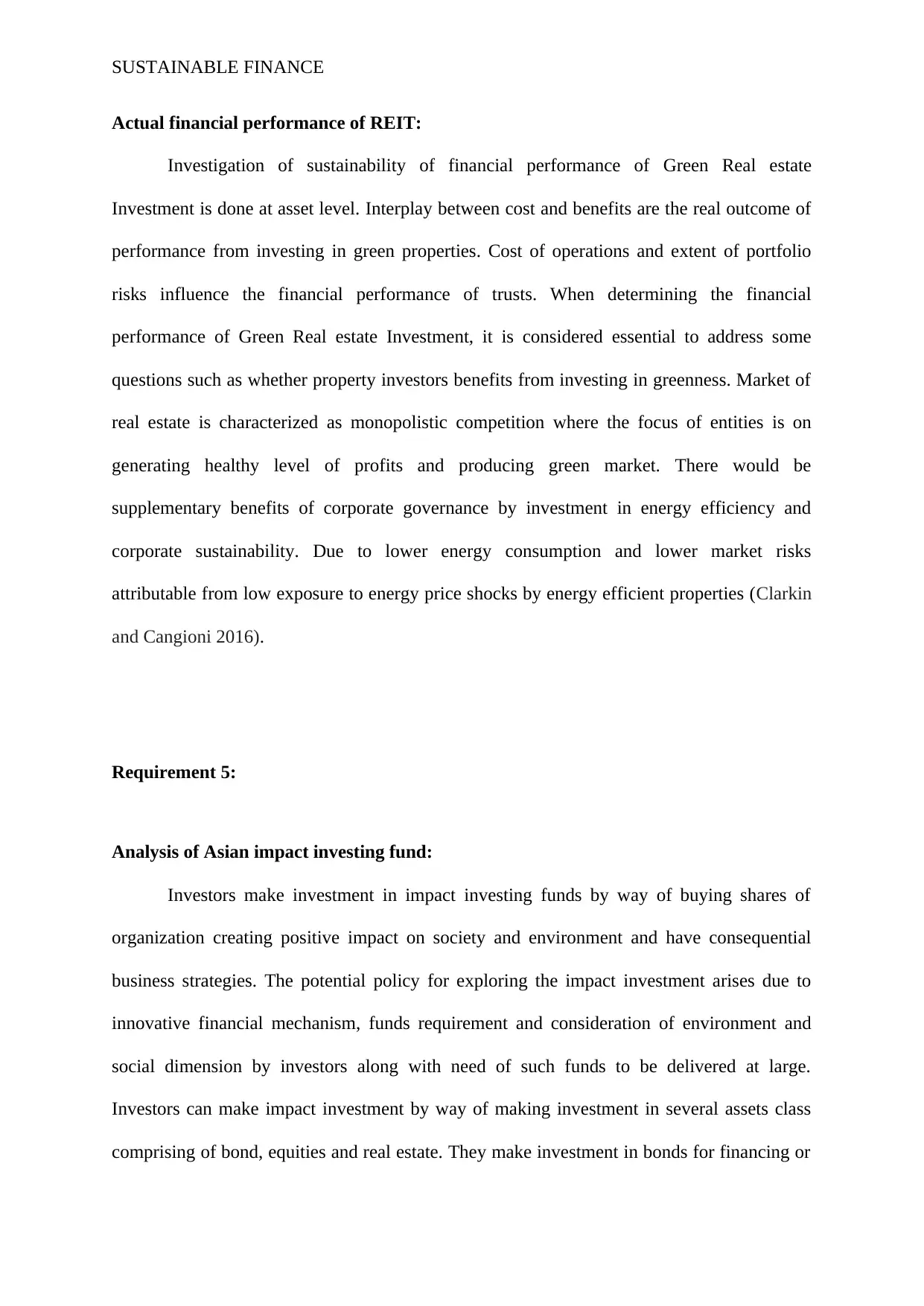
SUSTAINABLE FINANCE
Actual financial performance of REIT:
Investigation of sustainability of financial performance of Green Real estate
Investment is done at asset level. Interplay between cost and benefits are the real outcome of
performance from investing in green properties. Cost of operations and extent of portfolio
risks influence the financial performance of trusts. When determining the financial
performance of Green Real estate Investment, it is considered essential to address some
questions such as whether property investors benefits from investing in greenness. Market of
real estate is characterized as monopolistic competition where the focus of entities is on
generating healthy level of profits and producing green market. There would be
supplementary benefits of corporate governance by investment in energy efficiency and
corporate sustainability. Due to lower energy consumption and lower market risks
attributable from low exposure to energy price shocks by energy efficient properties (Clarkin
and Cangioni 2016).
Requirement 5:
Analysis of Asian impact investing fund:
Investors make investment in impact investing funds by way of buying shares of
organization creating positive impact on society and environment and have consequential
business strategies. The potential policy for exploring the impact investment arises due to
innovative financial mechanism, funds requirement and consideration of environment and
social dimension by investors along with need of such funds to be delivered at large.
Investors can make impact investment by way of making investment in several assets class
comprising of bond, equities and real estate. They make investment in bonds for financing or
Actual financial performance of REIT:
Investigation of sustainability of financial performance of Green Real estate
Investment is done at asset level. Interplay between cost and benefits are the real outcome of
performance from investing in green properties. Cost of operations and extent of portfolio
risks influence the financial performance of trusts. When determining the financial
performance of Green Real estate Investment, it is considered essential to address some
questions such as whether property investors benefits from investing in greenness. Market of
real estate is characterized as monopolistic competition where the focus of entities is on
generating healthy level of profits and producing green market. There would be
supplementary benefits of corporate governance by investment in energy efficiency and
corporate sustainability. Due to lower energy consumption and lower market risks
attributable from low exposure to energy price shocks by energy efficient properties (Clarkin
and Cangioni 2016).
Requirement 5:
Analysis of Asian impact investing fund:
Investors make investment in impact investing funds by way of buying shares of
organization creating positive impact on society and environment and have consequential
business strategies. The potential policy for exploring the impact investment arises due to
innovative financial mechanism, funds requirement and consideration of environment and
social dimension by investors along with need of such funds to be delivered at large.
Investors can make impact investment by way of making investment in several assets class
comprising of bond, equities and real estate. They make investment in bonds for financing or
⊘ This is a preview!⊘
Do you want full access?
Subscribe today to unlock all pages.

Trusted by 1+ million students worldwide
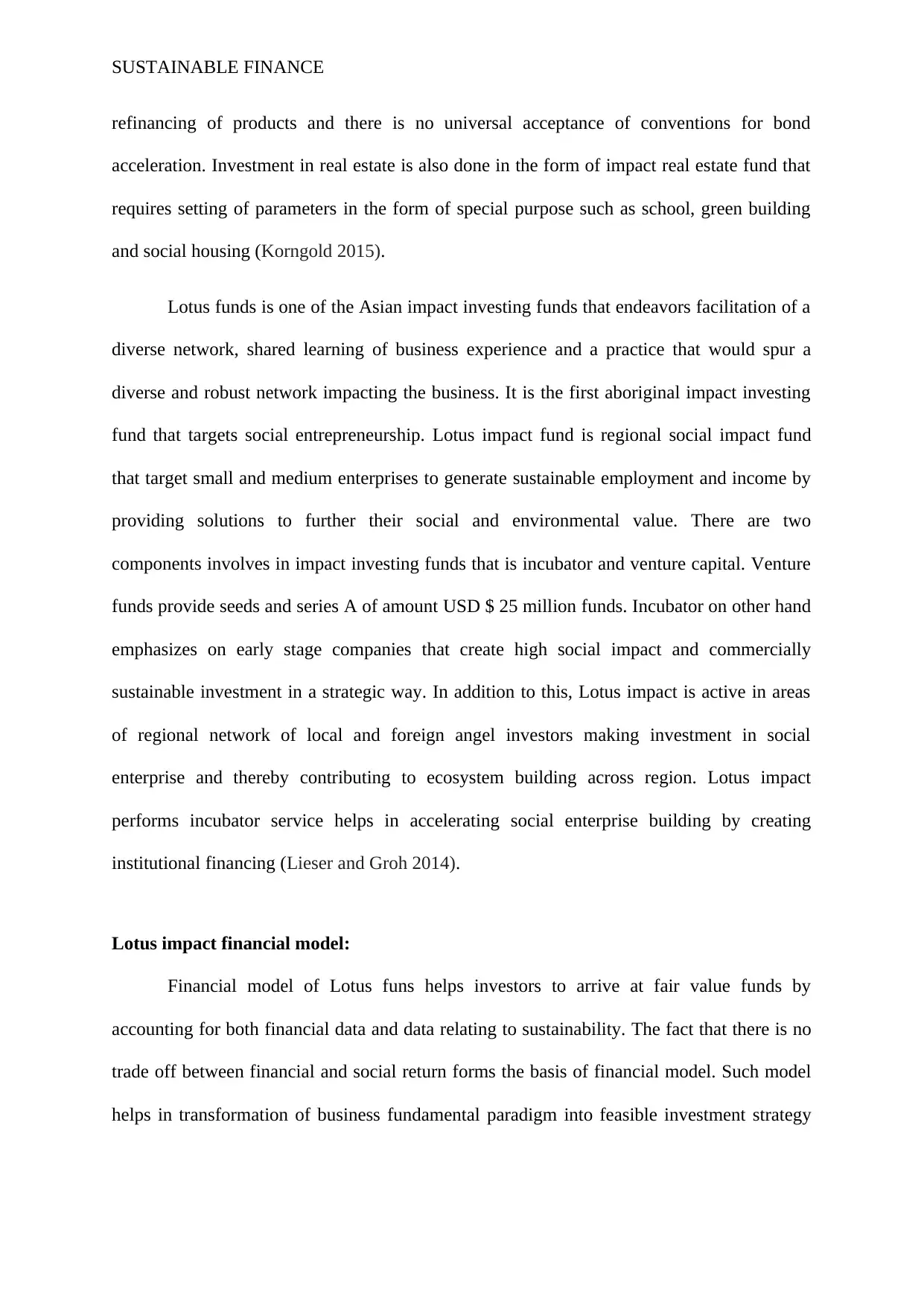
SUSTAINABLE FINANCE
refinancing of products and there is no universal acceptance of conventions for bond
acceleration. Investment in real estate is also done in the form of impact real estate fund that
requires setting of parameters in the form of special purpose such as school, green building
and social housing (Korngold 2015).
Lotus funds is one of the Asian impact investing funds that endeavors facilitation of a
diverse network, shared learning of business experience and a practice that would spur a
diverse and robust network impacting the business. It is the first aboriginal impact investing
fund that targets social entrepreneurship. Lotus impact fund is regional social impact fund
that target small and medium enterprises to generate sustainable employment and income by
providing solutions to further their social and environmental value. There are two
components involves in impact investing funds that is incubator and venture capital. Venture
funds provide seeds and series A of amount USD $ 25 million funds. Incubator on other hand
emphasizes on early stage companies that create high social impact and commercially
sustainable investment in a strategic way. In addition to this, Lotus impact is active in areas
of regional network of local and foreign angel investors making investment in social
enterprise and thereby contributing to ecosystem building across region. Lotus impact
performs incubator service helps in accelerating social enterprise building by creating
institutional financing (Lieser and Groh 2014).
Lotus impact financial model:
Financial model of Lotus funs helps investors to arrive at fair value funds by
accounting for both financial data and data relating to sustainability. The fact that there is no
trade off between financial and social return forms the basis of financial model. Such model
helps in transformation of business fundamental paradigm into feasible investment strategy
refinancing of products and there is no universal acceptance of conventions for bond
acceleration. Investment in real estate is also done in the form of impact real estate fund that
requires setting of parameters in the form of special purpose such as school, green building
and social housing (Korngold 2015).
Lotus funds is one of the Asian impact investing funds that endeavors facilitation of a
diverse network, shared learning of business experience and a practice that would spur a
diverse and robust network impacting the business. It is the first aboriginal impact investing
fund that targets social entrepreneurship. Lotus impact fund is regional social impact fund
that target small and medium enterprises to generate sustainable employment and income by
providing solutions to further their social and environmental value. There are two
components involves in impact investing funds that is incubator and venture capital. Venture
funds provide seeds and series A of amount USD $ 25 million funds. Incubator on other hand
emphasizes on early stage companies that create high social impact and commercially
sustainable investment in a strategic way. In addition to this, Lotus impact is active in areas
of regional network of local and foreign angel investors making investment in social
enterprise and thereby contributing to ecosystem building across region. Lotus impact
performs incubator service helps in accelerating social enterprise building by creating
institutional financing (Lieser and Groh 2014).
Lotus impact financial model:
Financial model of Lotus funs helps investors to arrive at fair value funds by
accounting for both financial data and data relating to sustainability. The fact that there is no
trade off between financial and social return forms the basis of financial model. Such model
helps in transformation of business fundamental paradigm into feasible investment strategy
Paraphrase This Document
Need a fresh take? Get an instant paraphrase of this document with our AI Paraphraser
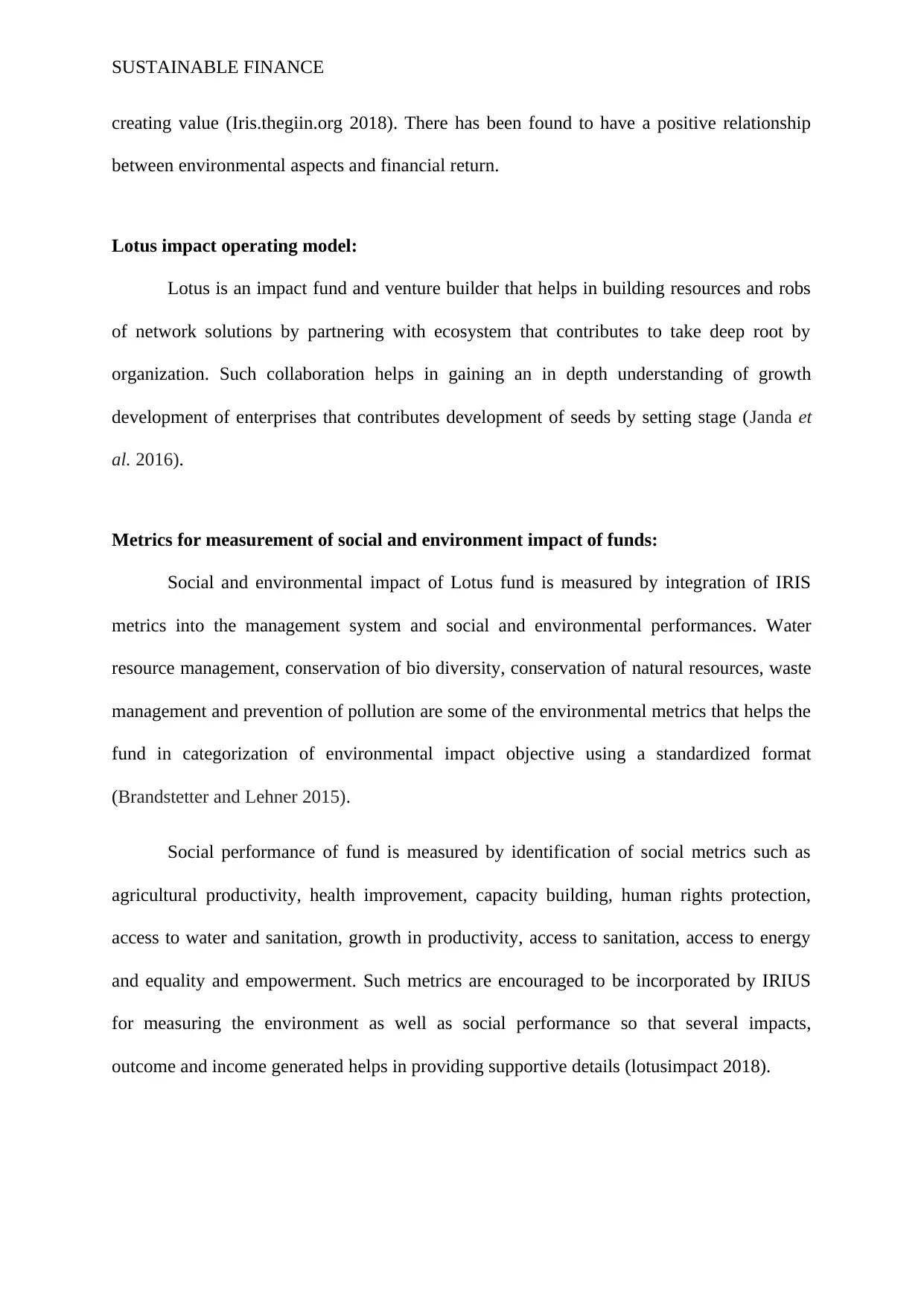
SUSTAINABLE FINANCE
creating value (Iris.thegiin.org 2018). There has been found to have a positive relationship
between environmental aspects and financial return.
Lotus impact operating model:
Lotus is an impact fund and venture builder that helps in building resources and robs
of network solutions by partnering with ecosystem that contributes to take deep root by
organization. Such collaboration helps in gaining an in depth understanding of growth
development of enterprises that contributes development of seeds by setting stage (Janda et
al. 2016).
Metrics for measurement of social and environment impact of funds:
Social and environmental impact of Lotus fund is measured by integration of IRIS
metrics into the management system and social and environmental performances. Water
resource management, conservation of bio diversity, conservation of natural resources, waste
management and prevention of pollution are some of the environmental metrics that helps the
fund in categorization of environmental impact objective using a standardized format
(Brandstetter and Lehner 2015).
Social performance of fund is measured by identification of social metrics such as
agricultural productivity, health improvement, capacity building, human rights protection,
access to water and sanitation, growth in productivity, access to sanitation, access to energy
and equality and empowerment. Such metrics are encouraged to be incorporated by IRIUS
for measuring the environment as well as social performance so that several impacts,
outcome and income generated helps in providing supportive details (lotusimpact 2018).
creating value (Iris.thegiin.org 2018). There has been found to have a positive relationship
between environmental aspects and financial return.
Lotus impact operating model:
Lotus is an impact fund and venture builder that helps in building resources and robs
of network solutions by partnering with ecosystem that contributes to take deep root by
organization. Such collaboration helps in gaining an in depth understanding of growth
development of enterprises that contributes development of seeds by setting stage (Janda et
al. 2016).
Metrics for measurement of social and environment impact of funds:
Social and environmental impact of Lotus fund is measured by integration of IRIS
metrics into the management system and social and environmental performances. Water
resource management, conservation of bio diversity, conservation of natural resources, waste
management and prevention of pollution are some of the environmental metrics that helps the
fund in categorization of environmental impact objective using a standardized format
(Brandstetter and Lehner 2015).
Social performance of fund is measured by identification of social metrics such as
agricultural productivity, health improvement, capacity building, human rights protection,
access to water and sanitation, growth in productivity, access to sanitation, access to energy
and equality and empowerment. Such metrics are encouraged to be incorporated by IRIUS
for measuring the environment as well as social performance so that several impacts,
outcome and income generated helps in providing supportive details (lotusimpact 2018).
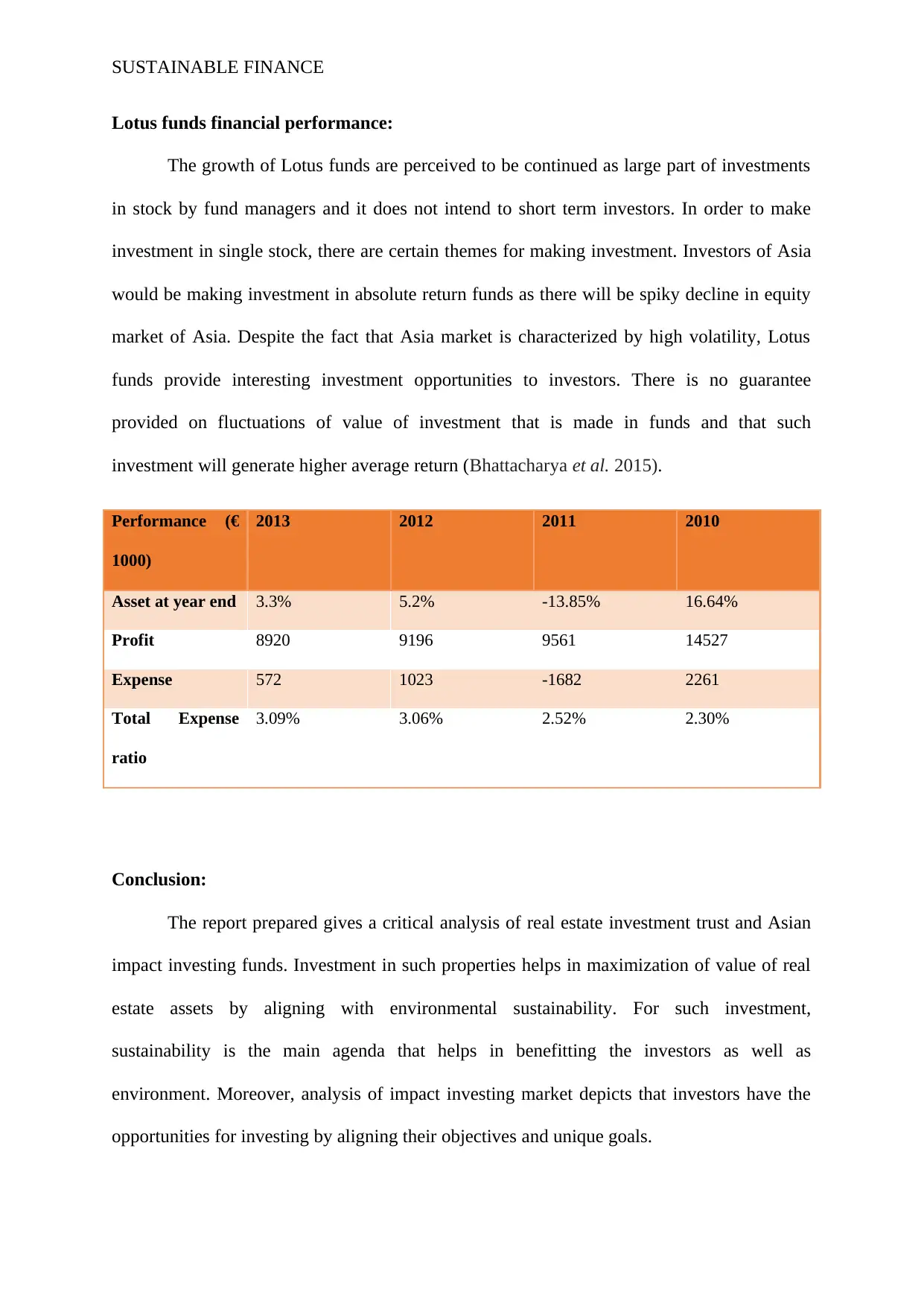
SUSTAINABLE FINANCE
Lotus funds financial performance:
The growth of Lotus funds are perceived to be continued as large part of investments
in stock by fund managers and it does not intend to short term investors. In order to make
investment in single stock, there are certain themes for making investment. Investors of Asia
would be making investment in absolute return funds as there will be spiky decline in equity
market of Asia. Despite the fact that Asia market is characterized by high volatility, Lotus
funds provide interesting investment opportunities to investors. There is no guarantee
provided on fluctuations of value of investment that is made in funds and that such
investment will generate higher average return (Bhattacharya et al. 2015).
Performance (€
1000)
2013 2012 2011 2010
Asset at year end 3.3% 5.2% -13.85% 16.64%
Profit 8920 9196 9561 14527
Expense 572 1023 -1682 2261
Total Expense
ratio
3.09% 3.06% 2.52% 2.30%
Conclusion:
The report prepared gives a critical analysis of real estate investment trust and Asian
impact investing funds. Investment in such properties helps in maximization of value of real
estate assets by aligning with environmental sustainability. For such investment,
sustainability is the main agenda that helps in benefitting the investors as well as
environment. Moreover, analysis of impact investing market depicts that investors have the
opportunities for investing by aligning their objectives and unique goals.
Lotus funds financial performance:
The growth of Lotus funds are perceived to be continued as large part of investments
in stock by fund managers and it does not intend to short term investors. In order to make
investment in single stock, there are certain themes for making investment. Investors of Asia
would be making investment in absolute return funds as there will be spiky decline in equity
market of Asia. Despite the fact that Asia market is characterized by high volatility, Lotus
funds provide interesting investment opportunities to investors. There is no guarantee
provided on fluctuations of value of investment that is made in funds and that such
investment will generate higher average return (Bhattacharya et al. 2015).
Performance (€
1000)
2013 2012 2011 2010
Asset at year end 3.3% 5.2% -13.85% 16.64%
Profit 8920 9196 9561 14527
Expense 572 1023 -1682 2261
Total Expense
ratio
3.09% 3.06% 2.52% 2.30%
Conclusion:
The report prepared gives a critical analysis of real estate investment trust and Asian
impact investing funds. Investment in such properties helps in maximization of value of real
estate assets by aligning with environmental sustainability. For such investment,
sustainability is the main agenda that helps in benefitting the investors as well as
environment. Moreover, analysis of impact investing market depicts that investors have the
opportunities for investing by aligning their objectives and unique goals.
⊘ This is a preview!⊘
Do you want full access?
Subscribe today to unlock all pages.

Trusted by 1+ million students worldwide
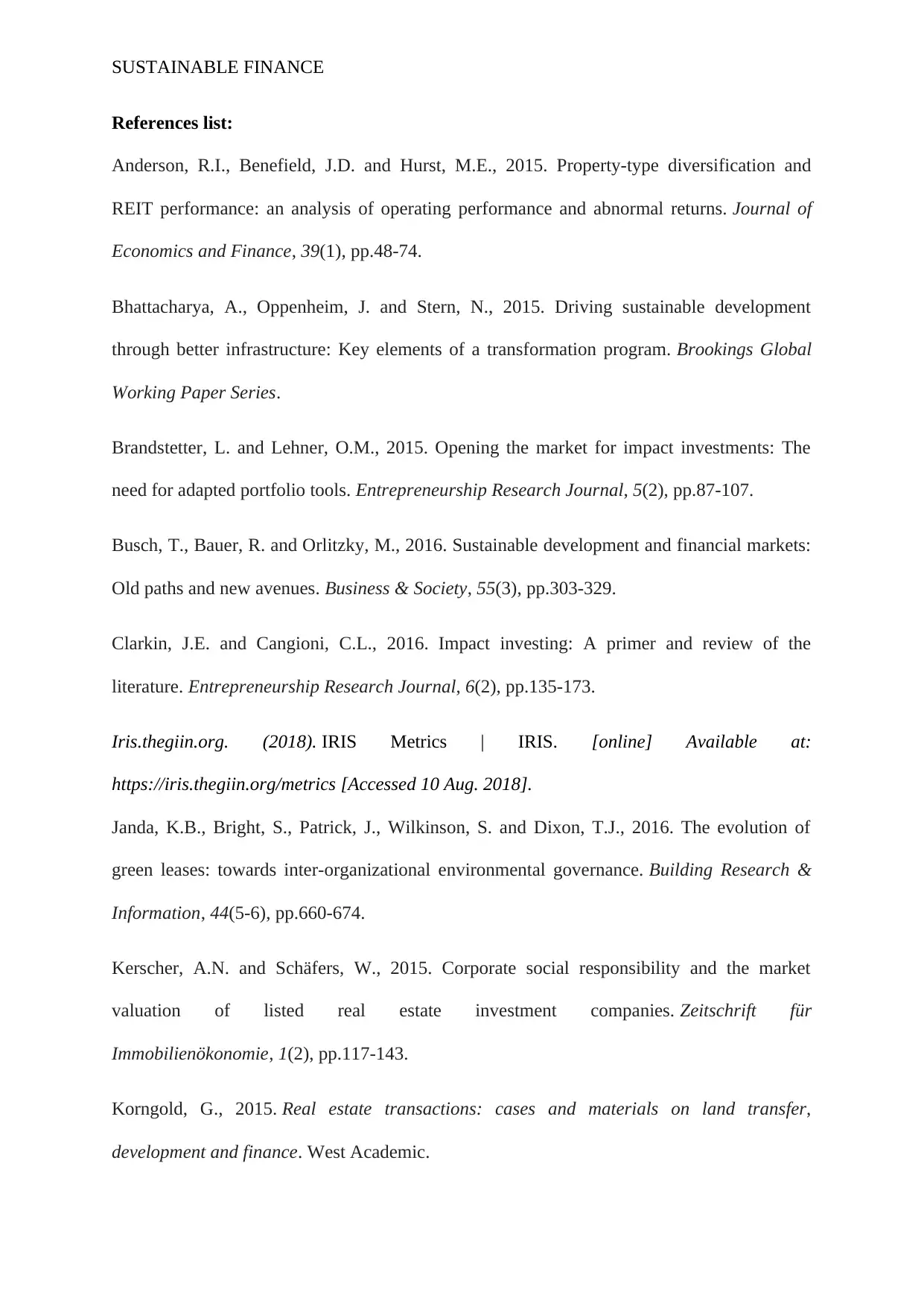
SUSTAINABLE FINANCE
References list:
Anderson, R.I., Benefield, J.D. and Hurst, M.E., 2015. Property-type diversification and
REIT performance: an analysis of operating performance and abnormal returns. Journal of
Economics and Finance, 39(1), pp.48-74.
Bhattacharya, A., Oppenheim, J. and Stern, N., 2015. Driving sustainable development
through better infrastructure: Key elements of a transformation program. Brookings Global
Working Paper Series.
Brandstetter, L. and Lehner, O.M., 2015. Opening the market for impact investments: The
need for adapted portfolio tools. Entrepreneurship Research Journal, 5(2), pp.87-107.
Busch, T., Bauer, R. and Orlitzky, M., 2016. Sustainable development and financial markets:
Old paths and new avenues. Business & Society, 55(3), pp.303-329.
Clarkin, J.E. and Cangioni, C.L., 2016. Impact investing: A primer and review of the
literature. Entrepreneurship Research Journal, 6(2), pp.135-173.
Iris.thegiin.org. (2018). IRIS Metrics | IRIS. [online] Available at:
https://iris.thegiin.org/metrics [Accessed 10 Aug. 2018].
Janda, K.B., Bright, S., Patrick, J., Wilkinson, S. and Dixon, T.J., 2016. The evolution of
green leases: towards inter-organizational environmental governance. Building Research &
Information, 44(5-6), pp.660-674.
Kerscher, A.N. and Schäfers, W., 2015. Corporate social responsibility and the market
valuation of listed real estate investment companies. Zeitschrift für
Immobilienökonomie, 1(2), pp.117-143.
Korngold, G., 2015. Real estate transactions: cases and materials on land transfer,
development and finance. West Academic.
References list:
Anderson, R.I., Benefield, J.D. and Hurst, M.E., 2015. Property-type diversification and
REIT performance: an analysis of operating performance and abnormal returns. Journal of
Economics and Finance, 39(1), pp.48-74.
Bhattacharya, A., Oppenheim, J. and Stern, N., 2015. Driving sustainable development
through better infrastructure: Key elements of a transformation program. Brookings Global
Working Paper Series.
Brandstetter, L. and Lehner, O.M., 2015. Opening the market for impact investments: The
need for adapted portfolio tools. Entrepreneurship Research Journal, 5(2), pp.87-107.
Busch, T., Bauer, R. and Orlitzky, M., 2016. Sustainable development and financial markets:
Old paths and new avenues. Business & Society, 55(3), pp.303-329.
Clarkin, J.E. and Cangioni, C.L., 2016. Impact investing: A primer and review of the
literature. Entrepreneurship Research Journal, 6(2), pp.135-173.
Iris.thegiin.org. (2018). IRIS Metrics | IRIS. [online] Available at:
https://iris.thegiin.org/metrics [Accessed 10 Aug. 2018].
Janda, K.B., Bright, S., Patrick, J., Wilkinson, S. and Dixon, T.J., 2016. The evolution of
green leases: towards inter-organizational environmental governance. Building Research &
Information, 44(5-6), pp.660-674.
Kerscher, A.N. and Schäfers, W., 2015. Corporate social responsibility and the market
valuation of listed real estate investment companies. Zeitschrift für
Immobilienökonomie, 1(2), pp.117-143.
Korngold, G., 2015. Real estate transactions: cases and materials on land transfer,
development and finance. West Academic.
Paraphrase This Document
Need a fresh take? Get an instant paraphrase of this document with our AI Paraphraser
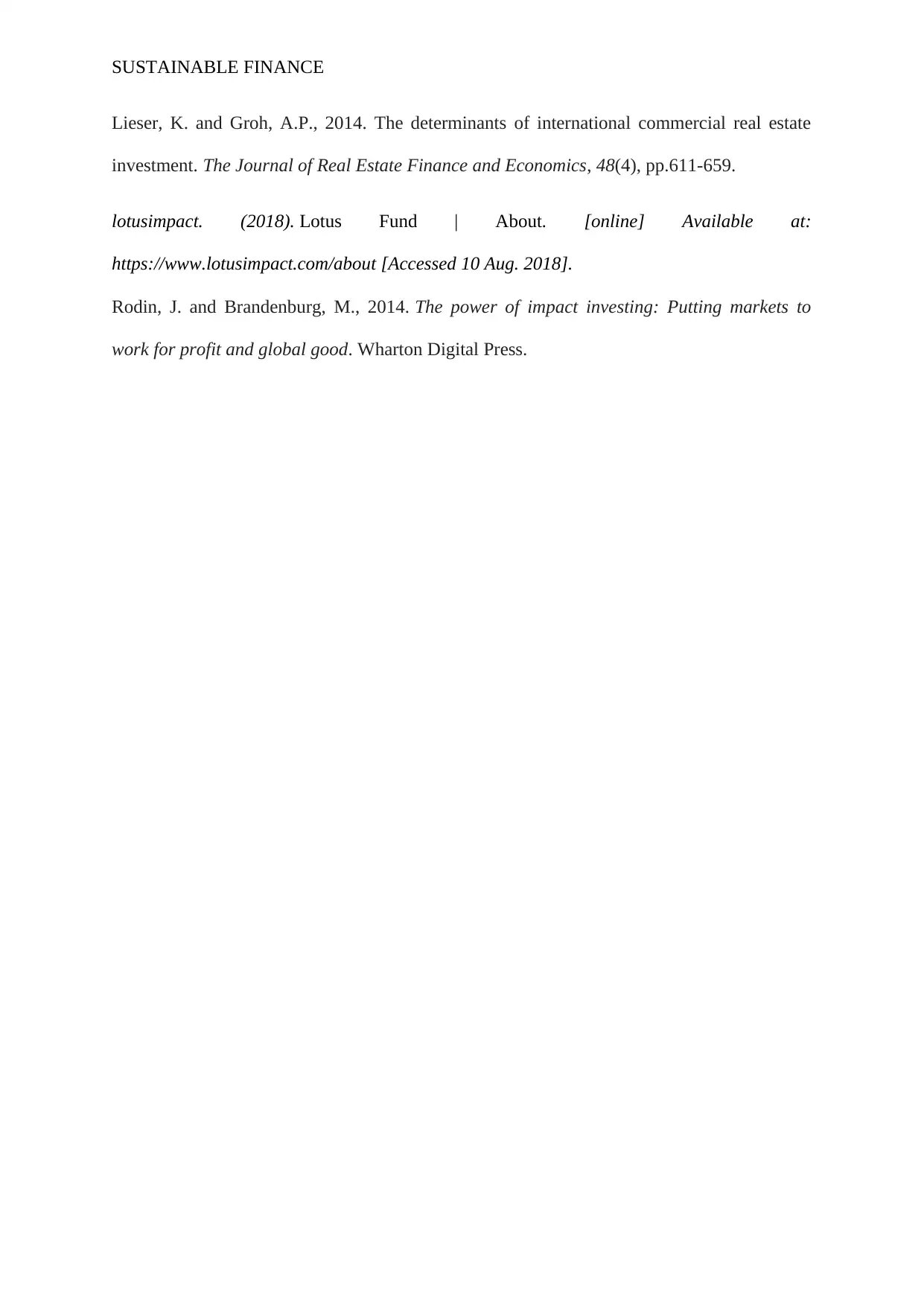
SUSTAINABLE FINANCE
Lieser, K. and Groh, A.P., 2014. The determinants of international commercial real estate
investment. The Journal of Real Estate Finance and Economics, 48(4), pp.611-659.
lotusimpact. (2018). Lotus Fund | About. [online] Available at:
https://www.lotusimpact.com/about [Accessed 10 Aug. 2018].
Rodin, J. and Brandenburg, M., 2014. The power of impact investing: Putting markets to
work for profit and global good. Wharton Digital Press.
Lieser, K. and Groh, A.P., 2014. The determinants of international commercial real estate
investment. The Journal of Real Estate Finance and Economics, 48(4), pp.611-659.
lotusimpact. (2018). Lotus Fund | About. [online] Available at:
https://www.lotusimpact.com/about [Accessed 10 Aug. 2018].
Rodin, J. and Brandenburg, M., 2014. The power of impact investing: Putting markets to
work for profit and global good. Wharton Digital Press.
1 out of 11
Related Documents
Your All-in-One AI-Powered Toolkit for Academic Success.
+13062052269
info@desklib.com
Available 24*7 on WhatsApp / Email
![[object Object]](/_next/static/media/star-bottom.7253800d.svg)
Unlock your academic potential
Copyright © 2020–2025 A2Z Services. All Rights Reserved. Developed and managed by ZUCOL.





